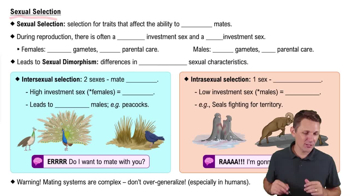Table of contents
- 1. Introduction to Biology2h 42m
- 2. Chemistry3h 40m
- 3. Water1h 26m
- 4. Biomolecules2h 23m
- 5. Cell Components2h 26m
- 6. The Membrane2h 31m
- 7. Energy and Metabolism2h 0m
- 8. Respiration2h 40m
- 9. Photosynthesis2h 49m
- 10. Cell Signaling59m
- 11. Cell Division2h 47m
- 12. Meiosis2h 0m
- 13. Mendelian Genetics4h 44m
- Introduction to Mendel's Experiments7m
- Genotype vs. Phenotype17m
- Punnett Squares13m
- Mendel's Experiments26m
- Mendel's Laws18m
- Monohybrid Crosses19m
- Test Crosses14m
- Dihybrid Crosses20m
- Punnett Square Probability26m
- Incomplete Dominance vs. Codominance20m
- Epistasis7m
- Non-Mendelian Genetics12m
- Pedigrees6m
- Autosomal Inheritance21m
- Sex-Linked Inheritance43m
- X-Inactivation9m
- 14. DNA Synthesis2h 27m
- 15. Gene Expression3h 20m
- 16. Regulation of Expression3h 31m
- Introduction to Regulation of Gene Expression13m
- Prokaryotic Gene Regulation via Operons27m
- The Lac Operon21m
- Glucose's Impact on Lac Operon25m
- The Trp Operon20m
- Review of the Lac Operon & Trp Operon11m
- Introduction to Eukaryotic Gene Regulation9m
- Eukaryotic Chromatin Modifications16m
- Eukaryotic Transcriptional Control22m
- Eukaryotic Post-Transcriptional Regulation28m
- Eukaryotic Post-Translational Regulation13m
- 17. Viruses37m
- 18. Biotechnology2h 58m
- 19. Genomics17m
- 20. Development1h 5m
- 21. Evolution3h 1m
- 22. Evolution of Populations3h 52m
- 23. Speciation1h 37m
- 24. History of Life on Earth2h 6m
- 25. Phylogeny2h 31m
- 26. Prokaryotes4h 59m
- 27. Protists1h 12m
- 28. Plants1h 22m
- 29. Fungi36m
- 30. Overview of Animals34m
- 31. Invertebrates1h 2m
- 32. Vertebrates50m
- 33. Plant Anatomy1h 3m
- 34. Vascular Plant Transport1h 2m
- 35. Soil37m
- 36. Plant Reproduction47m
- 37. Plant Sensation and Response1h 9m
- 38. Animal Form and Function1h 19m
- 39. Digestive System1h 10m
- 40. Circulatory System1h 57m
- 41. Immune System1h 12m
- 42. Osmoregulation and Excretion50m
- 43. Endocrine System1h 4m
- 44. Animal Reproduction1h 2m
- 45. Nervous System1h 55m
- 46. Sensory Systems46m
- 47. Muscle Systems23m
- 48. Ecology3h 11m
- Introduction to Ecology20m
- Biogeography14m
- Earth's Climate Patterns50m
- Introduction to Terrestrial Biomes10m
- Terrestrial Biomes: Near Equator13m
- Terrestrial Biomes: Temperate Regions10m
- Terrestrial Biomes: Northern Regions15m
- Introduction to Aquatic Biomes27m
- Freshwater Aquatic Biomes14m
- Marine Aquatic Biomes13m
- 49. Animal Behavior28m
- 50. Population Ecology3h 41m
- Introduction to Population Ecology28m
- Population Sampling Methods23m
- Life History12m
- Population Demography17m
- Factors Limiting Population Growth14m
- Introduction to Population Growth Models22m
- Linear Population Growth6m
- Exponential Population Growth29m
- Logistic Population Growth32m
- r/K Selection10m
- The Human Population22m
- 51. Community Ecology2h 46m
- Introduction to Community Ecology2m
- Introduction to Community Interactions9m
- Community Interactions: Competition (-/-)38m
- Community Interactions: Exploitation (+/-)23m
- Community Interactions: Mutualism (+/+) & Commensalism (+/0)9m
- Community Structure35m
- Community Dynamics26m
- Geographic Impact on Communities21m
- 52. Ecosystems2h 36m
- 53. Conservation Biology24m
49. Animal Behavior
Animal Behavior
Problem 10a`
Textbook Question
The tendency of individuals to choose mates who are like themselves is called
a. Natural selection
b. Sexual selection
c. Assortative mating
d. The founder effect
e. Random mating
 Verified step by step guidance
Verified step by step guidance1
Step 1: Understand the question. The problem is asking for the term that describes the tendency of individuals to choose mates who are similar to themselves. This is a concept related to mating behavior in biology.
Step 2: Review the provided options. The options are: (a) natural selection, (b) sexual selection, (c) assortative mating, (d) the founder effect, and (e) random mating. Each term has a specific definition in biology.
Step 3: Eliminate incorrect options. For example, natural selection (a) refers to the process where individuals with advantageous traits are more likely to survive and reproduce, which is not directly related to mate similarity. Random mating (e) refers to a situation where mates are chosen without regard to traits, which is the opposite of the behavior described in the question.
Step 4: Focus on the correct concept. Assortative mating (c) specifically refers to the tendency of individuals to choose mates who are similar to themselves in certain traits, such as size, color, or behavior. This matches the description in the question.
Step 5: Verify your understanding. Cross-check the definition of assortative mating with the question to ensure it aligns with the behavior described. This confirms that the correct answer is (c) assortative mating.
 Verified video answer for a similar problem:
Verified video answer for a similar problem:This video solution was recommended by our tutors as helpful for the problem above
Video duration:
1mPlay a video:
Was this helpful?
Key Concepts
Here are the essential concepts you must grasp in order to answer the question correctly.
Assortative Mating
Assortative mating is a mating pattern where individuals select partners with similar phenotypic traits, such as physical appearance or genetic characteristics. This behavior can lead to increased genetic similarity within a population and can influence evolutionary processes by affecting allele frequencies.
Recommended video:

Non-Random Mating
Sexual Selection
Sexual selection is a form of natural selection where individuals with certain traits are more likely to attract mates and reproduce. This can lead to the development of secondary sexual characteristics, such as elaborate plumage in birds, which may not necessarily enhance survival but improve mating success.
Recommended video:

Sexual Selection
Natural Selection
Natural selection is the process by which individuals with advantageous traits are more likely to survive and reproduce, leading to the gradual evolution of species. It operates on the principle that variations in traits can affect an organism's fitness in a given environment, shaping the genetic makeup of future generations.
Recommended video:

Natural Selection
Related Videos
Related Practice










































